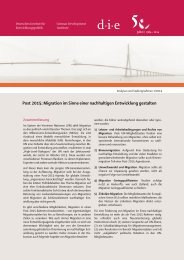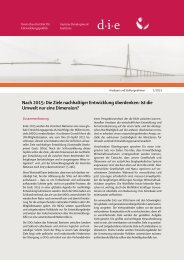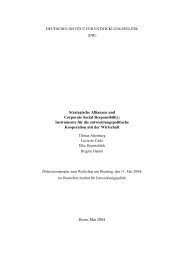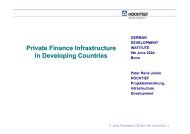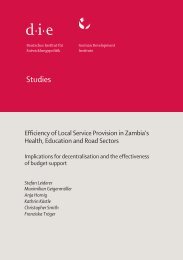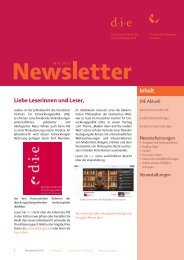Middle East / North Africa and the Millennium Development Goals ...
Middle East / North Africa and the Millennium Development Goals ...
Middle East / North Africa and the Millennium Development Goals ...
You also want an ePaper? Increase the reach of your titles
YUMPU automatically turns print PDFs into web optimized ePapers that Google loves.
<strong>Middle</strong> <strong>East</strong> / <strong>North</strong> <strong>Africa</strong> <strong>and</strong> <strong>the</strong> <strong>Millennium</strong> <strong>Development</strong> <strong>Goals</strong><br />
The overview <strong>the</strong>n indicated <strong>the</strong> urgency of problem-solution as regards<br />
<strong>the</strong> individual MDGs in <strong>the</strong> countries listed. The shaded boxes indicate<br />
that a country is faced with major problems in implementing one of more<br />
MDGs. This makes it clear for <strong>the</strong> reader which MENA countries are especially<br />
reliant on external support, <strong>and</strong> in which sector this support is<br />
needed: For Iraq <strong>and</strong> <strong>the</strong> low-income countries Yemen, Mauritania, <strong>and</strong><br />
Sudan, this is <strong>the</strong> case in nearly all sectors; only in Iran is <strong>the</strong> situation<br />
somewhat better. But it is possible to identify clear-cut priorities for <strong>the</strong><br />
remaining MENA countries. All of <strong>the</strong>m have major problems in implementing<br />
MDG1 (alleviation of poverty <strong>and</strong> hunger) <strong>and</strong> several targets of<br />
MDG8 (good governance, reduction of youth unemployment, access of <strong>the</strong><br />
population to modern technologies). Most of <strong>the</strong>se middle-income countries<br />
also have deficits with regard to MDG7 (environmental protection)<br />
MDG3 (political <strong>and</strong> social equality for women), <strong>and</strong> quality of primary<br />
school education – an aspect that <strong>the</strong> overview does not show clearly because<br />
no clear-cut indicators have been developed for it.<br />
The entries in <strong>the</strong> boxes of Overview 7 show, in keeping with <strong>the</strong> assumptions<br />
made above, <strong>the</strong> MDGs to which German DC is in a position to provide<br />
contributions within its priority sectors. However, <strong>the</strong> disposition of<br />
individual partner countries <strong>and</strong> priority partner countries to solve problems<br />
could not be shown in <strong>the</strong> overview since this would have impaired<br />
<strong>the</strong> clarity of <strong>the</strong> presentation – <strong>and</strong> because no reliable data are available.<br />
The comparative presentation clearly shows that German DC with <strong>the</strong><br />
MENA region is conducted primarily in sectors in which it is in a position<br />
to contribute to reaching MDG1 <strong>and</strong> MDG7 in particular. Thus far most of<br />
<strong>the</strong> MENA countries have made insufficient – or no – progress on <strong>the</strong>se<br />
two goals. On <strong>the</strong> o<strong>the</strong>r h<strong>and</strong>, German DC is hardly engaged at all in sectors<br />
like e.g. health, where it could contribute above all to reaching MDG4<br />
<strong>and</strong> MDG5, two goals that <strong>the</strong> MENA countries might well achieve.<br />
However, Overview 7 also shows that as a donor Germany has only a limited<br />
level of engagement in sectors marked by a high urgency to solve existing<br />
problems. Only in a few countries, for instance, is German DC supporting<br />
measures aimed at<br />
– promoting democracy <strong>and</strong> good governance (one target of MDG8;<br />
German <strong>Development</strong> Institute 135



